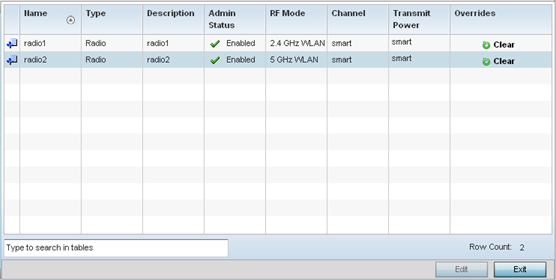Radio Override Configuration
About this task
An access point can have its radio profile configuration overridden after its radios have successfully associated to the network.
To define a radio configuration override from the access point‘s associated controller or service platform:
Procedure
-
Select Configuration → Devices from the web UI.
The Device Configuration screen displays a list of managed devices or peer controllers, service platforms, or access points.
-
Select a target device in the lower left-hand side of the UI.
You can also select a target device by double-clicking it in the list in the Device Configuration screen.The selected device's configuration menu displays.
- Go to Profile Overrides → Interface.
-
Select Radios.
 Device Overrides - Radios Screen
Device Overrides - Radios Screen

Note
A blue override icon (to the left of a parameter) defines the parameter as having an override applied. To remove an override go to the Basic Configuration section of the device and click Clear Overrides. This removes all overrides from the device. -
Review the following radio
configuration data to determine whether a radio configuration needs to be
modified or overridden to better support the managed network:
Name Displays whether the reporting radio is the access point's radio1, radio2 or radio3.
Type Displays whether the radio has been designated as a typical WLAN radio or if the radio has been designated as a sensor. Description A brief description provided by the administrator when the radio's configuration was added or modified. Admin Status A green check mark means the radio is enabled for client or sensor support. A red “X” means the radio is currently disabled. RF Mode Displays whether each listed radio is operating in the 802.11a/n or 802.11b/g/n radio band. If the radio is a dedicated sensor, it will be listed as a sensor to define the radio as not providing typical WLAN support. If the radio is a client bridge, it provides a typical bridging function and does not provide WLAN support. The radio band is set in the Radio Settings tab. Channel Lists the channel setting for the radio. Smart is the default setting. Smart indicates the acces spoint is set for dynamic Smart RF support. If set to Smart, the access point scans non-overlapping channels listening for beacons from other access points. After the channels are scanned, it selects the channel with the fewest access points. In the case of multiple access points on the same channel, it selects the channel with the lowest average power level. Transmit Power Lists the transmit power for each radio displayed as a value in milliwatts. Selecting smart allows the radio to perform power adjustments to compensate for failed neighboring radios.
Overrides A Clear option appears for each radio configuration that has an override applied to the profile‘s configuration. Select Clear to revert this specific radio configuration to the profile configuration originally defined by the administrator for this radio.


